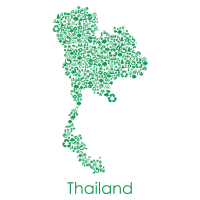1. Development
Over the past four decades, Thailand has made remarkable progress in social and economic development, moving from a low-income country to an upper-middle-income country in less than a generation.
As such, Thailand has been a widely cited development success story. This growth has created millions of jobs that have helped lift millions of people out of poverty. Gains across multiple dimensions of well-being have been impressive: more children are getting more years of education, and virtually everyone is now covered by health insurance while other forms of social security have expanded 1.
However, the growth prospects of the export-led model that not long ago fueled much of Thailand’s economic growth appear to have diminished significantly, due to stagnant productivity. Average total factor productivity (TFP) growth has stagnated from a high of 3.6% per year in the early 2000s to just 1.3% over the period 2009-2017. Private investment has declined from over 40% of GDP in 1997 to 16.9% of GDP in 2019, while foreign direct investment flows and participation in global value chains have shown signs of stagnation.
In addition, the COVID-19 pandemic has dealt a severe blow to the economy, exacerbating structural challenges. In 2020, the economy is estimated to have contracted by 6.1%. This decline is significantly larger than that experienced during the 2008 global financial crisis (0.3% in 2008) and second only to the 7.2% contraction in 1998, the largest economic contraction in the past 25 years.
Thailand has made significant progress in reducing poverty from 58% in 1990 to 6.8% in 2020, driven by high growth rates and structural transformation. Seventy-nine percent of the poor remain in rural areas, mostly in agricultural households. Poverty reduction in Thailand has slowed since 2015, with poverty increasing in 2016, 2018 and 2020, reflecting the economic slowdown, stagnant farm and business incomes and the COVID-19 crisis. The World Bank notes that in 2020, the poverty rate was more than 3 percentage points higher in rural areas than in urban areas, and the number of rural poor exceeded the number of urban poor by nearly 2.3 million. Poverty distribution has also been uneven across geographic regions, with the poverty rate in the South and Northeast nearly double the national poverty rate.
Thailand's economy is expected to recover to its pre -pandemic level between 2022 and 2023, but the pace of growth is threatened by geopolitical events and the repositioning of some international supply chains. The economy is expected to expand by 3.4% in 2022 and 3.6% in 2023. Growth in 2023 has been revised down by 0.7 percentage points from the previous projection, reflecting a faster-than-expected decline in global demand. The recovery of the tourism sector and private consumption will remain the main drivers of growth.
The increasing frequency of natural disasters poses a threat to economic growth, precisely because it has come at the expense of the environment and inclusion. Greenhouse gas emissions have increased significantly during the growth period, as has inequality between regions and businesses in the country. Thailand is a major polluter of plastic in the seas, on land, in river systems and along the coasts. With the National Action Plan on Marine Plastic Debris 2023-2027 and the Bio- Circular -Green Economy (BCG model), Thailand has set the goal of identifying public-private mechanisms for segregating plastic waste and improving plastic circularity.
According to Global Green Growth Institute (GGGI), Thailand is not yet fully exploiting the opportunities of the green economy. GGGI’s Green Growth Index provides policy makers with a benchmark to measure a country’s green growth performance, broken down into 4 dimensions of analysis: 1. Efficient and sustainable use of resources, 2. Protection of natural capital, 3. Green economic opportunities, and 4. Social inclusion. According to the Green Growth Index, Green economic opportunities is Thailand’s weakest green growth dimension. Overall, the country scores a total of 64.08 points with very mixed results ranging from high scores in Access to Basic Services, Social Equity, Environmental Quality, and Material Efficiency to lower scores in the Green Innovation and Green Trade segments. Green innovation is the area where Thailand lags behind even in regional comparison, despite the country’s ambitions to pursue a higher value-added economic model, which would be driven by an active innovation ecosystem 2.
The 13th National Economic and Social Development Plan of Thailand, for the period 2023 to 2027, aims to achieve five objectives:
-
Restructuring production, in an innovation-based economy that aligns with technological trends and global trade; this will involve promoting research and development of innovation.
-
Developing people/human resources to have the capacity and quality of life suitable for the new world; this would involve developing essential skills for the 21st century, as well as improving schools and teachers
-
Creating a society of opportunity and equity; this means reducing social inequalities and increasing well-being for people and increasing equal access for the less privileged.
-
Creating Sustainability for the country, taking into account the environment and ecosystem, solving environmental problems and strengthening green industry and economy.
-
Preparing the country to face risks and changes in a new global context
The plan's annual budget for development projects is expected to be between 500 billion and 600 billion baht (about US$14.6 billion – 17.6 billion). The budget for development projects was at least 20 percent of the entire fiscal budget under the 12th plan, which ran from 2017 to 22. The new development framework for the 13th National Economic and Social Development Plan emphasizes high value-added economic growth. A high value- added economy focuses on activities that result in a large profit margin between the final price of a good or service and the cost of the inputs needed to produce it, resulting in higher profits for businesses and higher wages for workers.
1https://www.worldbank.org/en/country/thailand/overview
2https://dicf.unepgrid.ch/thailand/green-economy
